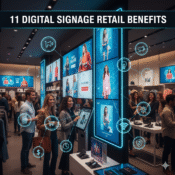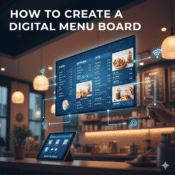
The Narrowcasting Handbook: Examples, Definitions & Software Guide
In the fast-evolving world of digital signage, narrowcasting has emerged as one of the most powerful tools for delivering precise, audience-specific content. Unlike traditional broadcasting, which sends a single message to a wide audience, narrowcasting focuses on delivering tailored, context-relevant messages to specific groups or locations. This targeted communication approach has revolutionized how businesses engage with their audiences across retail, healthcare, education, and corporate sectors.
For organizations looking to enhance communication efficiency and customer engagement, narrowcasting offers measurable results through personalized, data-driven content delivery. As one of the leading names in digital signage technology, ScreensHub provides advanced narrowcasting solutions that help businesses design, manage, and scale digital communication across multiple locations—seamlessly and effectively.
This guide, The Narrowcasting Handbook, explores the concept, benefits, applications, and software behind narrowcasting, helping businesses understand how to leverage ScreensHub’s platform to create impactful, targeted digital signage campaigns.
Understanding Narrowcasting
What Is Narrowcasting?
Narrowcasting refers to delivering targeted digital messages to specific audiences through digital displays. It contrasts with broadcasting, which delivers general content to mass audiences. In narrowcasting, content is customized based on audience characteristics such as location, demographics, time of day, or behavior—ensuring that every message is relevant and impactful.
In the context of digital signage, narrowcasting is often referred to as:
- Targeted digital signage
- Micro-targeted messaging
- Segmented content delivery
Each of these terms underscores the core idea: reaching the right audience with the right content at the right time.
Narrowcasting vs. Broadcasting
| Aspect | Narrowcasting | Broadcasting |
| Audience | Specific, segmented | Broad, general |
| Content | Personalized and dynamic | Universal and static |
| Engagement | High, due to relevance | Lower, due to generalization |
| Purpose | Influence specific behaviors | Inform or entertain mass audiences |
With digital signage networks becoming smarter, narrowcasting empowers organizations to create meaningful interactions and measurable results—something traditional broadcasting simply cannot achieve.
How Narrowcasting Works in Digital Signage
The Technical Foundation
Modern narrowcasting relies on a blend of audience data, content management systems (CMS), and real-time analytics. Businesses use ScreensHub’s cloud-based digital signage software to schedule, update, and analyze content performance across multiple screens and locations.
The process includes:
- Audience Segmentation – Identifying specific groups (e.g., shoppers, employees, patients) based on demographics, time, or behavior.
- Content Customization – Creating tailored messages or offers that appeal to these segments.
- Dynamic Content Delivery – Using ScreensHub’s CMS to automate content updates and adjust messaging in real time.
- Data Integration – Connecting IoT devices, POS systems, or sensors to trigger responsive content based on contextual factors (weather, sales data, or foot traffic).
The Role of Analytics and IoT
With the integration of IoT sensors and audience analytics, narrowcasting goes beyond static communication. For instance, a display in a retail store can automatically switch from promoting coffee to smoothies when the temperature rises—making content contextually intelligent.
ScreensHub enables this level of adaptability, giving marketers and facility managers the power to manage complex narrowcasting networks effortlessly.
Practical Applications and Examples
1. Retail
In retail environments, narrowcasting digital signage delivers personalized promotions, flash deals, and localized advertising. For example:
- Promoting seasonal items during specific times of the day.
- Displaying weather-based offers (“Stay cool with our iced coffee!”).
- Highlighting loyalty rewards or in-store events.
2. Corporate Communications
Within enterprises, narrowcasting supports internal communication and productivity through:
- Employee recognition boards.
- Meeting room scheduling screens.
- Performance dashboards and training reminders.
3. Healthcare
Hospitals and clinics use narrowcasting to:
- Share patient check-in updates.
- Display health tips in waiting areas.
- Guide visitors with dynamic wayfinding systems.
4. Education
Universities and schools benefit from digital narrowcasting networks that:
- Announce class schedules or campus events.
- Deliver emergency alerts or safety instructions.
- Display digital learning content.
5. Hospitality and Transportation
Hotels, airports, and public transport systems deploy narrowcasting for:
- Guest information and localized offers.
- Emergency notifications.
- Real-time flight, train, or bus updates.
ScreensHub provides comprehensive solutions for each of these sectors, helping organizations deliver the right message to the right screen at the right moment.
Benefits of Narrowcasting with Digital Signage
1. Enhanced Engagement
Relevant, timely content captures attention and drives action. Narrowcasting increases engagement because audiences see messages tailored to their needs and context.
2. Better ROI
Unlike mass advertising, narrowcasting minimizes waste by focusing resources on specific audience segments, ensuring higher conversion rates and reduced ad spend.
3. Scalability and Flexibility
ScreensHub’s narrowcasting platform allows businesses to manage thousands of screens from one dashboard, making it easy to scale campaigns globally while maintaining local relevance.
4. Improved Brand Experience
When businesses communicate in a personalized, consistent way, they strengthen brand perception and customer loyalty.
ScreensHub supports these outcomes by combining intelligent content delivery with powerful analytics, ensuring every campaign delivers measurable impact.
Choosing the Right Narrowcasting Software
Selecting the right software is the foundation of an effective narrowcasting strategy.
Key Features to Look For
- User-Friendly CMS: Simple interface for scheduling and managing content.
- Real-Time Updates: Automatically refreshes screens across locations.
- Audience Analytics: Monitors engagement and performance.
- Multi-Location Management: Centralized control for multiple displays.
- Integration Capabilities: Compatible with existing hardware and systems.
Why Choose ScreensHub
ScreensHub’s digital signage software for narrowcasting offers:
- Intuitive cloud-based CMS for effortless content management.
- Advanced scheduling and automation tools.
- Real-time analytics and reporting dashboards.
- Seamless integration with existing screens and hardware.
- 24/7 technical support and software customization options.
With ScreensHub, businesses gain a complete, scalable narrowcasting solution—from initial setup to ongoing optimization.
Getting Started with ScreensHub for Narrowcasting
Step 1: Consultation
ScreensHub’s experts assess your communication goals, audience types, and existing infrastructure to design a custom narrowcasting plan.
Step 2: Software Setup
Clients are onboarded to ScreensHub’s cloud-based CMS, enabling easy access to all screens and content scheduling tools.
Step 3: Content Strategy
The creative team assists in developing targeted content strategies aligned with audience segments and business objectives.
Step 4: Deployment
ScreensHub’s technical specialists handle installation, network setup, and testing to ensure smooth performance.
Step 5: Continuous Optimization
Through built-in analytics, clients can monitor performance, A/B test campaigns, and refine strategies with ScreensHub’s ongoing support.
Businesses can request a free consultation or demo by visiting screenshub.com, ensuring a smooth transition to an intelligent narrowcasting network.
Future Trends in Narrowcasting and Digital Signage
AI and Predictive Targeting
Artificial intelligence will enable signage systems to analyze audience behavior in real time and adjust content dynamically for maximum impact.
Enhanced Interactivity
Touchscreen displays and mobile integrations (via QR codes or NFC) will expand opportunities for two-way audience engagement.
Wider Sector Adoption
Sectors like real estate, government, and entertainment are increasingly adopting narrowcasting to communicate effectively with niche audiences.
Sustainability and Efficiency
By reducing printed materials and enabling remote updates, narrowcasting supports eco-friendly communication strategies.
ScreensHub continues to lead innovation in this space, helping clients stay future-ready with cutting-edge technology and solutions.
Conclusion
As this Narrowcasting Handbook demonstrates, targeted digital signage is transforming how organizations communicate. From retail promotions to corporate dashboards, narrowcasting ensures every message is personalized, relevant, and data-driven—resulting in higher engagement and better ROI.
With ScreensHub’s industry expertise, intuitive software, and end-to-end support, businesses can deploy narrowcasting networks that enhance audience experience and operational efficiency.
To discover how narrowcasting can revolutionize your digital communication, visit screenshub.com today for a personalized consultation or product demo.



